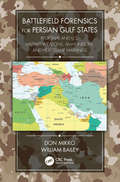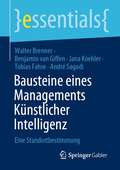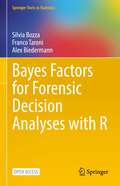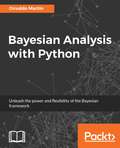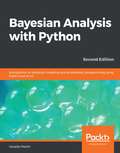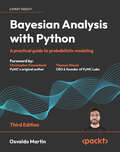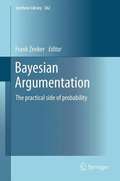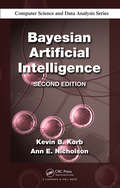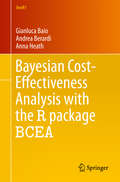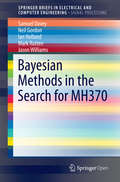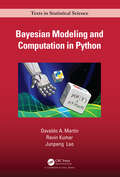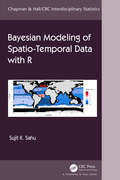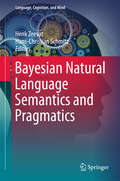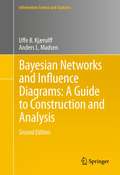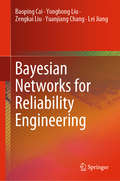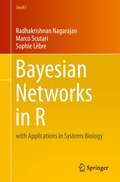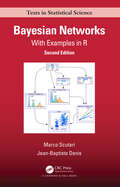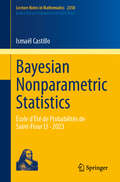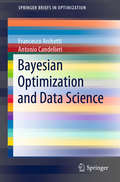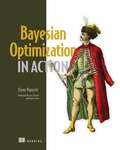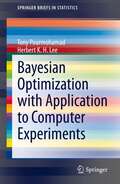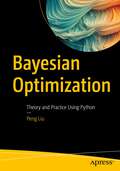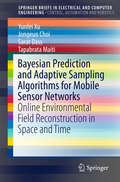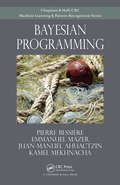- Table View
- List View
Battlefield Forensics for Persian Gulf States: Regional and U.S. Military Weapons, Ammunition, and Headstamp Markings
by Don Mikko William BaileyBattlefield Forensics for Persian Gulf States provides an illustrative reference of various weapons, toolmarks, headstamps, and other traits in order to identify the origins of a variety of guns, casings, and ammunition that can be found in the Middle East. Various conflicts in the region have led to innumerable weapons being used throughout the years. The lead author, Don Mikko, has investigated and examined firearms related items of evidence in countless crime scenes throughout the world. As the Chief of the Firearms Branch at the United States Army Criminal Investigation Laboratory (USACIL), Fort Gillem, Georgia, he recruited, trained, and competency tested military contractors deploying to various combat related areas of the world, those providing forensic firearm and toolmark identification support to local commanders. What was learned was that various foreign weapons and ammunition were being utilized in conflicts and by opposing forces. This book educates readers on the technical data for different types of firearms, ammunition, countries of origin, proof marks, penetrator information and the typical firearm markings imparted on fired cartridge cases, such as breech-face, firing pin, ejector, and extractor markings. Forensics and biometrics within the Persian Gulf have been leveraged since the early 1990s and many of the firearms and types of ammunition covered in this handbook are addressed in an effort to assist those on the ground who are required to be able to identify such items in various scenarios. The information contained within the book has proven to be effective on the battlefield and has helped shape combat operations. This handbook will serve as a useful reference not only to assist military and contractor personnel within the various combat locations but will also prove to be beneficial for law-enforcement, crime laboratory personnel, forensic firearm and toolmark examiners, crime scene investigators, students, practitioners, and civilian personnel throughout the world.
Battute, Meme, Immagini & Storie Divertenti sui Pokemon
by Hiddenstuff EntertainmentOttieni un accesso istantaneo alle battute più divertenti sui Pokemon! Scoprirai le battute più divertenti di sempre sui Pokemon. Questo libro è pieno con alcune delle battute più divertenti del mondo sui Pokemon. Scopri i personaggi più popolari dei Pokemon con battute e meme stupidi, ridicoli e semplicemente che fanno morire dal ridere su di loro! Scarica ora la tua copia! Purchase today and discover all of the most popular jokes for mario bros!
Bausteine eines Managements Künstlicher Intelligenz: Eine Standortbestimmung (essentials)
by Walter Brenner Benjamin van Giffen Jana Koehler Tobias Fahse André SagodiAlgorithmen Künstlicher Intelligenz werden stetig weiterentwickelt und kommen in immer mehr Anwendungen in Wirtschaft und Gesellschaft zum Einsatz. Es werden professionelle Prozesse und Strukturen benötigt, um Anwendungen zu entwickeln, zu betreiben und in den betrieblichen Kontext zu integrieren. Dieses essential beschreibt die grundsätzlichen Prozesse eines Managements Künstlicher Intelligenz und zeigt Beispiele für konkreten unternehmerischen Nutzen.
Bayes Factors for Forensic Decision Analyses with R (Springer Texts in Statistics)
by Silvia Bozza Franco Taroni Alex BiedermannBayes Factors for Forensic Decision Analyses with R provides a self-contained introduction to computational Bayesian statistics using R. With its primary focus on Bayes factors supported by data sets, this book features an operational perspective, practical relevance, and applicability—keeping theoretical and philosophical justifications limited. It offers a balanced approach to three naturally interrelated topics:Probabilistic Inference - Relies on the core concept of Bayesian inferential statistics, to help practicing forensic scientists in the logical and balanced evaluation of the weight of evidence.Decision Making - Features how Bayes factors are interpreted in practical applications to help address questions of decision analysis involving the use of forensic science in the law.Operational Relevance - Combines inference and decision, backed up with practical examples and complete sample code in R, including sensitivity analyses and discussion on how to interpret results in context.Over the past decades, probabilistic methods have established a firm position as a reference approach for the management of uncertainty in virtually all areas of science, including forensic science, with Bayes' theorem providing the fundamental logical tenet for assessing how new information—scientific evidence—ought to be weighed. Central to this approach is the Bayes factor, which clarifies the evidential meaning of new information, by providing a measure of the change in the odds in favor of a proposition of interest, when going from the prior to the posterior distribution. Bayes factors should guide the scientist's thinking about the value of scientific evidence and form the basis of logical and balanced reporting practices, thus representing essential foundations for rational decision making under uncertainty.This book would be relevant to students, practitioners, and applied statisticians interested in inference and decision analyses in the critical field of forensic science. It could be used to support practical courses on Bayesian statistics and decision theory at both undergraduate and graduate levels, and will be of equal interest to forensic scientists and practitioners of Bayesian statistics for driving their evaluations and the use of R for their purposes.This book is Open Access.
Bayesian Analysis with Python
by Tony CampbellYou will need a basic understanding of OpenStack, Linux, and Cloud computing. If you have an understanding of Linux, this book will help you leverage that knowledge in the world of OpenStack, giving you confidence to tackle most issues that may arise.
Bayesian Analysis with Python - Second Edition: Introduction to statistical modeling and probabilistic programming using PyMC3 and ArviZ, 2nd Edition
by Osvaldo MartinBayesian Analysis with Python is for you if you are a data scientist, researcher, or developer looking to get started with Bayesian data analysis and probabilistic programming. Although you need not have any previous statistical knowledge, some experience in using Python is expected.
Bayesian Analysis with Python: A practical guide to probabilistic modeling
by Osvaldo MartinLearn the fundamentals of Bayesian modeling using state-of-the-art Python libraries, such as PyMC, ArviZ, Bambi, and more, guided by an experienced Bayesian modeler who contributes to these librariesKey FeaturesConduct Bayesian data analysis with step-by-step guidanceGain insight into a modern, practical, and computational approach to Bayesian statistical modelingEnhance your learning with best practices through sample problems and practice exercisesPurchase of the print or Kindle book includes a free PDF eBook.Book DescriptionThe third edition of Bayesian Analysis with Python serves as an introduction to the main concepts of applied Bayesian modeling using PyMC, a state-of-the-art probabilistic programming library, and other libraries that support and facilitate modeling like ArviZ, for exploratory analysis of Bayesian models; Bambi, for flexible and easy hierarchical linear modeling; PreliZ, for prior elicitation; PyMC-BART, for flexible non-parametric regression; and Kulprit, for variable selection. In this updated edition, a brief and conceptual introduction to probability theory enhances your learning journey by introducing new topics like Bayesian additive regression trees (BART), featuring updated examples. Refined explanations, informed by feedback and experience from previous editions, underscore the book's emphasis on Bayesian statistics. You will explore various models, including hierarchical models, generalized linear models for regression and classification, mixture models, Gaussian processes, and BART, using synthetic and real datasets. By the end of this book, you will possess a functional understanding of probabilistic modeling, enabling you to design and implement Bayesian models for your data science challenges. You'll be well-prepared to delve into more advanced material or specialized statistical modeling if the need arises.What you will learnBuild probabilistic models using PyMC and BambiAnalyze and interpret probabilistic models with ArviZAcquire the skills to sanity-check models and modify them if necessaryBuild better models with prior and posterior predictive checksLearn the advantages and caveats of hierarchical modelsCompare models and choose between alternative onesInterpret results and apply your knowledge to real-world problemsExplore common models from a unified probabilistic perspectiveApply the Bayesian framework's flexibility for probabilistic thinkingWho this book is forIf you are a student, data scientist, researcher, or developer looking to get started with Bayesian data analysis and probabilistic programming, this book is for you. The book is introductory, so no previous statistical knowledge is required, although some experience in using Python and scientific libraries like NumPy is expected.
Bayesian Argumentation: The practical side of probability (Synthese Library #362)
by Frank ZenkerRelevant to, and drawing from, a range of disciplines, the chapters in this collection show the diversity, and applicability, of research in Bayesian argumentation. Together, they form a challenge to philosophers versed in both the use and criticism of Bayesian models who have largely overlooked their potential in argumentation. Selected from contributions to a multidisciplinary workshop on the topic held in Sweden in 2010, the authors count linguists and social psychologists among their number, in addition to philosophers. They analyze material that includes real-life court cases, experimental research results, and the insights gained from computer models. The volume provides, for the first time, a formal measure of subjective argument strength and argument force, robust enough to allow advocates of opposing sides of an argument to agree on the relative strengths of their supporting reasoning. With papers from leading figures such as Michael Oaksford and Ulrike Hahn, the book comprises recent research conducted at the frontiers of Bayesian argumentation and provides a multitude of examples in which these formal tools can be applied to informal argument. It signals new and impending developments in philosophy, which has seen Bayesian models deployed in formal epistemology and philosophy of science, but has yet to explore the full potential of Bayesian models as a framework in argumentation. In doing so, this revealing anthology looks destined to become a standard teaching text in years to come.
Bayesian Artificial Intelligence (Chapman & Hall/CRC Computer Science & Data Analysis)
by Kevin B. Korb Ann E. NicholsonThe second edition of this bestseller provides a practical and accessible introduction to the main concepts, foundation, and applications of Bayesian networks. This edition contains a new chapter on Bayesian network classifiers and a new section on object-oriented Bayesian networks, along with new applications and case studies. It includes a new section that addresses foundational problems with causal discovery and Markov blanket discovery and a new section that covers methods of evaluating causal discovery programs. The book also offers more coverage on the uses of causal interventions to understand and reason with causal Bayesian networks. Supplemental materials are available on the book's website.
Bayesian Cost-Effectiveness Analysis with the R package BCEA (Use R!)
by Gianluca Baio Andrea Berardi Anna HeathThe book provides a description of the process of health economic evaluation and modelling for cost-effectiveness analysis, particularly from the perspective of a Bayesian statistical approach. Some relevant theory and introductory concepts are presented using practical examples and two running case studies. The book also describes in detail how to perform health economic evaluations using the R package BCEA (Bayesian Cost-Effectiveness Analysis). BCEA can be used to post-process the results of a Bayesian cost-effectiveness model and perform advanced analyses producing standardised and highly customisable outputs. It presents all the features of the package, including its many functions and their practical application, as well as its user-friendly web interface. The book is a valuable resource for statisticians and practitioners working in the field of health economics wanting to simplify and standardise their workflow, for example in the preparation of dossiers in support of marketing authorisation, or academic and scientific publications.
Bayesian Methods in the Search for MH370 (SpringerBriefs in Electrical and Computer Engineering)
by Neil Gordon Jason Williams Sam Davey Ian Holland Mark RuttenThis book demonstrates how nonlinear/non-Gaussian Bayesian time series estimation methods were used to produce a probability distribution of potential MH370 flight paths. It provides details of how the probabilistic models of aircraft flight dynamics, satellite communication system measurements, environmental effects and radar data were constructed and calibrated. The probability distribution was used to define the search zone in the southern Indian Ocean.The book describes particle-filter based numerical calculation of the aircraft flight-path probability distribution and validates the method using data from several of the involved aircraft’s previous flights. Finally it is shown how the Reunion Island flaperon debris find affects the search probability distribution.
Bayesian Modeling and Computation in Python (Chapman & Hall/CRC Texts in Statistical Science)
by Osvaldo A. Martin Ravin Kumar Junpeng LaoBayesian Modeling and Computation in Python aims to help beginner Bayesian practitioners to become intermediate modelers. It uses a hands on approach with PyMC3, Tensorflow Probability, ArviZ and other libraries focusing on the practice of applied statistics with references to the underlying mathematical theory. The book starts with a refresher of the Bayesian Inference concepts. The second chapter introduces modern methods for Exploratory Analysis of Bayesian Models. With an understanding of these two fundamentals the subsequent chapters talk through various models including linear regressions, splines, time series, Bayesian additive regression trees. The final chapters include Approximate Bayesian Computation, end to end case studies showing how to apply Bayesian modelling in different settings, and a chapter about the internals of probabilistic programming languages. Finally the last chapter serves as a reference for the rest of the book by getting closer into mathematical aspects or by extending the discussion of certain topics. This book is written by contributors of PyMC3, ArviZ, Bambi, and Tensorflow Probability among other libraries.
Bayesian Modeling of Spatio-Temporal Data with R (Chapman & Hall/CRC Interdisciplinary Statistics)
by Sujit SahuApplied sciences, both physical and social, such as atmospheric, biological, climate, demographic, economic, ecological, environmental, oceanic and political, routinely gather large volumes of spatial and spatio-temporal data in order to make wide ranging inference and prediction. Ideally such inferential tasks should be approached through modelling, which aids in estimation of uncertainties in all conclusions drawn from such data. Unified Bayesian modelling, implemented through user friendly software packages, provides a crucial key to unlocking the full power of these methods for solving challenging practical problems. Key features of the book: • Accessible detailed discussion of a majority of all aspects of Bayesian methods and computations with worked examples, numerical illustrations and exercises • A spatial statistics jargon buster chapter that enables the reader to build up a vocabulary without getting clouded in modeling and technicalities • Computation and modeling illustrations are provided with the help of the dedicated R package bmstdr, allowing the reader to use well-known packages and platforms, such as rstan, INLA, spBayes, spTimer, spTDyn, CARBayes, CARBayesST, etc • Included are R code notes detailing the algorithms used to produce all the tables and figures, with data and code available via an online supplement • Two dedicated chapters discuss practical examples of spatio-temporal modeling of point referenced and areal unit data • Throughout, the emphasis has been on validating models by splitting data into test and training sets following on the philosophy of machine learning and data science This book is designed to make spatio-temporal modeling and analysis accessible and understandable to a wide audience of students and researchers, from mathematicians and statisticians to practitioners in the applied sciences. It presents most of the modeling with the help of R commands written in a purposefully developed R package to facilitate spatio-temporal modeling. It does not compromise on rigour, as it presents the underlying theories of Bayesian inference and computation in standalone chapters, which would be appeal those interested in the theoretical details. By avoiding hard core mathematics and calculus, this book aims to be a bridge that removes the statistical knowledge gap from among the applied scientists.
Bayesian Natural Language Semantics and Pragmatics (Language, Cognition, and Mind #2)
by Henk Zeevat Hans-Christian SchmitzThe contributions in this volume focus on the Bayesian interpretation of natural languages, which is widely used in areas of artificial intelligence, cognitive science, and computational linguistics. This is the first volume to take up topics in Bayesian Natural Language Interpretation and make proposals based on information theory, probability theory, and related fields. The methodologies offered here extend to the target semantic and pragmatic analyses of computational natural language interpretation. Bayesian approaches to natural language semantics and pragmatics are based on methods from signal processing and the causal Bayesian models pioneered by especially Pearl. In signal processing, the Bayesian method finds the most probable interpretation by finding the one that maximizes the product of the prior probability and the likelihood of the interpretation. It thus stresses the importance of a production model for interpretation as in Grice's contributions to pragmatics or in interpretation by abduction.
Bayesian Networks and Influence Diagrams: A Guide To Construction And Analysis (Information Science and Statistics #22)
by Uffe B. Kjærulff Anders L. MadsenBayesian Networks and Influence Diagrams: A Guide to Construction and Analysis, Second Edition, provides a comprehensive guide for practitioners who wish to understand, construct, and analyze intelligent systems for decision support based on probabilistic networks. This new edition contains six new sections, in addition to fully-updated examples, tables, figures, and a revised appendix. Intended primarily for practitioners, this book does not require sophisticated mathematical skills or deep understanding of the underlying theory and methods nor does it discuss alternative technologies for reasoning under uncertainty. The theory and methods presented are illustrated through more than 140 examples, and exercises are included for the reader to check his or her level of understanding. The techniques and methods presented for knowledge elicitation, model construction and verification, modeling techniques and tricks, learning models from data, and analyses of models have all been developed and refined on the basis of numerous courses that the authors have held for practitioners worldwide.
Bayesian Networks for Reliability Engineering
by Lei Jiang Baoping Cai Yonghong Liu Zengkai Liu Yuanjiang ChangThis book presents a bibliographical review of the use of Bayesian networks in reliability over the last decade. Bayesian network (BN) is considered to be one of the most powerful models in probabilistic knowledge representation and inference, and it is increasingly used in the field of reliability. After focusing on the engineering systems, the book subsequently discusses twelve important issues in the BN-based reliability methodologies, such as BN structure modeling, BN parameter modeling, BN inference, validation, and verification. As such, it is a valuable resource for researchers and practitioners in the field of reliability engineering.
Bayesian Networks in R: with Applications in Systems Biology (Use R! #48)
by Marco Scutari Radhakrishnan Nagarajan Sophie LèbreBayesian Networks in R with Applications in Systems Biology is unique as it introduces the reader to the essential concepts in Bayesian network modeling and inference in conjunction with examples in the open-source statistical environment R. The level of sophistication is also gradually increased across the chapters with exercises and solutions for enhanced understanding for hands-on experimentation of the theory and concepts. The application focuses on systems biology with emphasis on modeling pathways and signaling mechanisms from high-throughput molecular data. Bayesian networks have proven to be especially useful abstractions in this regard. Their usefulness is especially exemplified by their ability to discover new associations in addition to validating known ones across the molecules of interest. It is also expected that the prevalence of publicly available high-throughput biological data sets may encourage the audience to explore investigating novel paradigms using the approaches presented in the book.
Bayesian Networks: With Examples in R (Chapman & Hall/CRC Texts in Statistical Science #109)
by Marco Scutari Jean-Baptiste DenisBayesian Networks: With Examples in R, Second Edition introduces Bayesian networks using a hands-on approach. Simple yet meaningful examples illustrate each step of the modelling process and discuss side-by-side the underlying theory and its application using R code. The examples start from the simplest notions and gradually increase in complexity. In particular, this new edition contains significant new material on topics from modern machine learning practice: dynamic networks, networks with heterogeneous variables, and model validation. The first three chapters explain the whole process of Bayesian network modelling, from structure learning to parameter learning to inference. These chapters cover discrete, Gaussian, and conditional Gaussian Bayesian networks. The following two chapters delve into dynamic networks (to model temporal data) and into networks including arbitrary random variables (using Stan). The book then gives a concise but rigorous treatment of the fundamentals of Bayesian networks and offers an introduction to causal Bayesian networks. It also presents an overview of R packages and other software implementing Bayesian networks. The final chapter evaluates two real-world examples: a landmark causal protein-signaling network published in Science and a probabilistic graphical model for predicting the composition of different body parts. Covering theoretical and practical aspects of Bayesian networks, this book provides you with an introductory overview of the field. It gives you a clear, practical understanding of the key points behind this modelling approach and, at the same time, it makes you familiar with the most relevant packages used to implement real-world analyses in R. The examples covered in the book span several application fields, data-driven models and expert systems, probabilistic and causal perspectives, thus giving you a starting point to work in a variety of scenarios. Online supplementary materials include the data sets and the code used in the book, which will all be made available from https://www.bnlearn.com/book-crc-2ed/
Bayesian Nonparametric Statistics: École d’Été de Probabilités de Saint-Flour LI - 2023 (Lecture Notes in Mathematics #2358)
by Ismaël CastilloThis up-to-date overview of Bayesian nonparametric statistics provides both an introduction to the field and coverage of recent research topics, including deep neural networks, high-dimensional models and multiple testing, Bernstein-von Mises theorems and variational Bayes approximations, many of which have previously only been accessible through research articles. Although Bayesian posterior distributions are widely applied in astrophysics, inverse problems, genomics, machine learning and elsewhere, their theory is still only partially understood, especially in complex settings such as nonparametric or semiparametric models. Here, the available theory on the frequentist analysis of posterior distributions is outlined in terms of convergence rates, limiting shape results and uncertainty quantification. Based on lecture notes for a course given at the St-Flour summer school in 2023, the book is aimed at researchers and graduate students in statistics and probability.
Bayesian Optimization and Data Science (SpringerBriefs in Optimization)
by Francesco Archetti Antonio CandelieriThis volume brings together the main results in the field of Bayesian Optimization (BO), focusing on the last ten years and showing how, on the basic framework, new methods have been specialized to solve emerging problems from machine learning, artificial intelligence, and system optimization. It also analyzes the software resources available for BO and a few selected application areas. Some areas for which new results are shown include constrained optimization, safe optimization, and applied mathematics, specifically BO's use in solving difficult nonlinear mixed integer problems. The book will help bring readers to a full understanding of the basic Bayesian Optimization framework and gain an appreciation of its potential for emerging application areas. It will be of particular interest to the data science, computer science, optimization, and engineering communities.
Bayesian Optimization in Action (In Action)
by Quan NguyenBayesian optimization helps pinpoint the best configuration for your machine learning models with speed and accuracy. Put its advanced techniques into practice with this hands-on guide.In Bayesian Optimization in Action you will learn how to: Train Gaussian processes on both sparse and large data sets Combine Gaussian processes with deep neural networks to make them flexible and expressive Find the most successful strategies for hyperparameter tuning Navigate a search space and identify high-performing regions Apply Bayesian optimization to cost-constrained, multi-objective, and preference optimization Implement Bayesian optimization with PyTorch, GPyTorch, and BoTorch Bayesian Optimization in Action shows you how to optimize hyperparameter tuning, A/B testing, and other aspects of the machine learning process by applying cutting-edge Bayesian techniques. Using clear language, illustrations, and concrete examples, this book proves that Bayesian optimization doesn&’t have to be difficult! You&’ll get in-depth insights into how Bayesian optimization works and learn how to implement it with cutting-edge Python libraries. The book&’s easy-to-reuse code samples let you hit the ground running by plugging them straight into your own projects. Forewords by Luis Serrano and David Sweet. About the technology In machine learning, optimization is about achieving the best predictions—shortest delivery routes, perfect price points, most accurate recommendations—in the fewest number of steps. Bayesian optimization uses the mathematics of probability to fine-tune ML functions, algorithms, and hyperparameters efficiently when traditional methods are too slow or expensive. About the book Bayesian Optimization in Action teaches you how to create efficient machine learning processes using a Bayesian approach. In it, you&’ll explore practical techniques for training large datasets, hyperparameter tuning, and navigating complex search spaces. This interesting book includes engaging illustrations and fun examples like perfecting coffee sweetness, predicting weather, and even debunking psychic claims. You&’ll learn how to navigate multi-objective scenarios, account for decision costs, and tackle pairwise comparisons. What's inside Gaussian processes for sparse and large datasets Strategies for hyperparameter tuning Identify high-performing regions Examples in PyTorch, GPyTorch, and BoTorch About the reader For machine learning practitioners who are confident in math and statistics. About the author Quan Nguyen is a research assistant at Washington University in St. Louis. He writes for the Python Software Foundation and has authored several books on Python programming. Table of Contents 1 Introduction to Bayesian optimization 2 Gaussian processes as distributions over functions 3 Customizing a Gaussian process with the mean and covariance functions 4 Refining the best result with improvement-based policies 5 Exploring the search space with bandit-style policies 6 Leveraging information theory with entropy-based policies 7 Maximizing throughput with batch optimization 8 Satisfying extra constraints with constrained optimization 9 Balancing utility and cost with multifidelity optimization 10 Learning from pairwise comparisons with preference optimization 11 Optimizing multiple objectives at the same time 12 Scaling Gaussian processes to large datasets 13 Combining Gaussian processes with neural networks
Bayesian Optimization with Application to Computer Experiments (SpringerBriefs in Statistics)
by Tony Pourmohamad Herbert K. H. LeeThis book introduces readers to Bayesian optimization, highlighting advances in the field and showcasing its successful applications to computer experiments. R code is available as online supplementary material for most included examples, so that readers can better comprehend and reproduce methods. Compact and accessible, the volume is broken down into four chapters. Chapter 1 introduces the reader to the topic of computer experiments; it includes a variety of examples across many industries. Chapter 2 focuses on the task of surrogate model building and contains a mix of several different surrogate models that are used in the computer modeling and machine learning communities. Chapter 3 introduces the core concepts of Bayesian optimization and discusses unconstrained optimization. Chapter 4 moves on to constrained optimization, and showcases some of the most novel methods found in the field. This will be a useful companion to researchers and practitioners working with computer experiments and computer modeling. Additionally, readers with a background in machine learning but minimal background in computer experiments will find this book an interesting case study of the applicability of Bayesian optimization outside the realm of machine learning.
Bayesian Optimization: Theory and Practice Using Python
by Peng LiuThis book covers the essential theory and implementation of popular Bayesian optimization techniques in an intuitive and well-illustrated manner. The techniques covered in this book will enable you to better tune the hyperparemeters of your machine learning models and learn sample-efficient approaches to global optimization.The book begins by introducing different Bayesian Optimization (BO) techniques, covering both commonly used tools and advanced topics. It follows a “develop from scratch” method using Python, and gradually builds up to more advanced libraries such as BoTorch, an open-source project introduced by Facebook recently. Along the way, you’ll see practical implementations of this important discipline along with thorough coverage and straightforward explanations of essential theories. This book intends to bridge the gap between researchers and practitioners, providing both with a comprehensive, easy-to-digest, and useful reference guide. After completing this book, you will have a firm grasp of Bayesian optimization techniques, which you’ll be able to put into practice in your own machine learning models.What You Will LearnApply Bayesian Optimization to build better machine learning modelsUnderstand and research existing and new Bayesian Optimization techniquesLeverage high-performance libraries such as BoTorch, which offer you the ability to dig into and edit the inner workingDig into the inner workings of common optimization algorithms used to guide the search process in Bayesian optimizationWho This Book Is ForBeginner to intermediate level professionals in machine learning, analytics or other roles relevant in data science.
Bayesian Prediction and Adaptive Sampling Algorithms for Mobile Sensor Networks: Online Environmental Field Reconstruction in Space and Time (SpringerBriefs in Electrical and Computer Engineering)
by Jongeun Choi Yunfei Xu Sarat Dass Tapabrata MaitiThis brief introduces a class of problems and models for the prediction of the scalar field of interest from noisy observations collected by mobile sensor networks. It also introduces the problem of optimal coordination of robotic sensors to maximize the prediction quality subject to communication and mobility constraints either in a centralized or distributed manner. To solve such problems, fully Bayesian approaches are adopted, allowing various sources of uncertainties to be integrated into an inferential framework effectively capturing all aspects of variability involved. The fully Bayesian approach also allows the most appropriate values for additional model parameters to be selected automatically by data, and the optimal inference and prediction for the underlying scalar field to be achieved. In particular, spatio-temporal Gaussian process regression is formulated for robotic sensors to fuse multifactorial effects of observations, measurement noise, and prior distributions for obtaining the predictive distribution of a scalar environmental field of interest. New techniques are introduced to avoid computationally prohibitive Markov chain Monte Carlo methods for resource-constrained mobile sensors. Bayesian Prediction and Adaptive Sampling Algorithms for Mobile Sensor Networks starts with a simple spatio-temporal model and increases the level of model flexibility and uncertainty step by step, simultaneously solving increasingly complicated problems and coping with increasing complexity, until it ends with fully Bayesian approaches that take into account a broad spectrum of uncertainties in observations, model parameters, and constraints in mobile sensor networks. The book is timely, being very useful for many researchers in control, robotics, computer science and statistics trying to tackle a variety of tasks such as environmental monitoring and adaptive sampling, surveillance, exploration, and plume tracking which are of increasing currency. Problems are solved creatively by seamless combination of theories and concepts from Bayesian statistics, mobile sensor networks, optimal experiment design, and distributed computation.
Bayesian Programming (Chapman & Hall/CRC Machine Learning & Pattern Recognition)
by Pierre Bessiere Emmanuel Mazer Juan Ahuactzin Kamel MekhnachaA new modeling methodology, new inference algorithms, new programming languages, and new hardware are all needed to create a complete Bayesian computing framework. Focusing on the methodology and algorithms, this book describes the first steps toward reaching that goal. It emphasizes probability as an alternative to Boolean logic, covering new methods to build probabilistic programs for real-world applications. The book encourages readers to explore emerging areas and develop new programming languages and hardware architectures. A Python package is available on a supplementary website.
